Framework for Remote Sensing and Modelling of Lithium-Brine Deposit Formation
Abstract
:1. Introduction
2. Materials and Methods
2.1. Test Site
2.2. Remote Sensing Data and Initial Baseline
3. Geological Processing
4. Hydrogeological Processing
5. Mass Balance Derivation
5.1. MODFLOW Model
- Transmissivity based on a constant 100 m thickness combined with hydraulic conductivity distribution;
- Rivers—drain cells based on river network derived from national dataset (World Bank);
- Evaporation based on salar outline.
5.2. MODPATH Model
5.3. Mass Balance
6. Conclusions
Author Contributions
Funding
Institutional Review Board Statement
Informed Consent Statement
Data Availability Statement
Acknowledgments
Conflicts of Interest
Appendix A. Hydrogeological Units Used for the Groundwater Flow Model Development
| UnitID | Geological UnitCode | HydrogeologicalCode | ParentRockType | GeologicalDefinition | Hydraulic Conductivity(m/d) | Porosity(%) |
| 1 | Pzs | Pzs | Sedimentary rocks | Pzs: Sedimentary rocks (Palaeozoic) Chiefly marine sandstone and shale of Devonian to Ordovician age. Rocks are generally highly folded and locally penetratively deformed. | 0.1 | 20 |
| 2, 3 | Ks | FRSC | Sedimentary rocks | Ks: Sedimentary rocks (Cretaceous) Marine and nonmarine sandstone, shale, marl, and limestone. | 0.5 | 20 |
| 4 | Ts1 | FRSC | Sedimentary rocks | Ts1: Sedimentary rocks (Oligocene to Paleocene) Nonmarine, mostly reddish coloured conglomerate, sandstone, shale, and mudstone. | 0.5 | 20 |
| 5 | Tig | CLIC | Pyroclastic rocks | Tig: Pyroclastic rocks (Miocene and Oligocene) Chiefly welded to nonwelded ash-flow tuffs, but includes air-fall tuffs and thin, volcaniclastic beds. Mostly dacitic in composition. | 0.5 | 25 |
| 6 | Tdp | FRSC | Gypsum diapirs | Tdp: Gypsum diapirs (Miocene to Eocene?) May include halite and other evaporite minerals. | 0.5 | 1 |
| 7 | Tvnd | CLIC | Volcanic rocks | Tvnd: Volcanic rocks, undifferentiated (Miocene and Oligocene) Chiefly lava flows, but includes extensive pyroclastic deposits and intrusive rocks in some areas where not mapped separately as units Tig and Ti, and locally may include interbedded nonmarine sedimentry rocks. Mostly of andesitic and dacitic composition; sources are poorly defined volcanic eruptive centres, now deeply eroded. | 5 | 25 |
| 8 | Tmf | LAIF | Pyroclastic rocks | Tmf: Los Frailes and Morococala Ignimbrites (Miocene). | 0.5 | 25 |
| 9 | Ti | CLIC | Intrusive rocks | Ti: Intrusive rocks (Pliocene to Oligocene) Chiefly subvolcanic stocks, plugs, and dikes of dacitic composition in vent complex of eroded volcanic eruptive centres. | 0.5 | 3 |
| 10 | Ts2 | FRSC | Sedimentary rocks | Ts2: Sedimentary rocks (Pliocene to Oligocene) Nonmarine sandstone, conglomerate, shale, marl, and evaporites. | 0.5 | 20 |
| 11 | QTs | CCS | Sedimentary rocks | QTs: Sedimentary rocks (Pleistocene and Pliocene) Nonmarine sandstone, conglomerate, and shale. May include minor interlayered volcanic rocks. | 5 | 25 |
| 12 | Qtig | IRG | Pyroclastic rocks | QTig: Ignimbrite (Pleistocene to Miocene) Welded and nonwelded ash-flow tuffs, chiefly in extensive outflow sheets. Mostly of dacitic composition. | 5 | 25 |
| 13 | Qtev | FEV | Volcanic rocks | QTev: Stratovolcano deposits (Holocene to Miocene) Lava flows, flow breccias, lahars, and minor pyroclastic deposits chiefly of andesitic to dacitic composition. | 0.5 | 10 |
| 14 | Ql | LL L | Lacustrine sediments | Ql: Lacustrine deposits (Holocene and Pleistocene) Chiefly calcareous tufa in ancient lake shorelines and lacustrine mud and silt deposits. | 5 | 30 |
| 15 | Qsu | Qsu | Unconsolidated sediments | Qsu: Surficial deposits, undifferentiated (Holocene and Pleistocene) Includes unconsolidated alluvial, aeolian, colluvial, and glacial deposits. Locally may include lacustrine and salt deposits that are not shown separately. | 5 | 30 |
| 16 | Qs | Qs | Evaporites | Qs: Salt deposits (Holocene and Pleistocene) Salar / playa-lake evaporites. May include interbedded fine-grained lacustrine deposits. | 20 | 20 |
Appendix B. Data Requirements for the Groundwater Flow Model Development
| Task | Activity | DataRequirements | Issues |
| Conceptual model of groundwater flow and solute transport | Develop understanding of occurrence of groundwater flow along with rock mass that contributes Li and other solutes to the inflow to the salar at the watershed scale | -3D geological understanding -Distribution of parameters: transmissivity, storage coefficients, porosity, and exchange coefficients for leaching Li from host rocks-Groundwater flowpaths (piezometric surface) -Groundwater hydrographs (30 years) -Groundwater geochemistry to inform -Output: 3D conceptual understanding of groundwater flow at the watershed scale | Need to establish depth of groundwater flow in watershed |
| Water balance: surface and groundwater | |||
| Recharge model (incl. runoff) | Static data: -DEM—25 m resolution (ASCII gridded) -River network (shapefile) -Land cover map—vector/1 km gridded -Soil map—vector/1 km gridded -Geology map—vector/1 km gridded Driving data: -Rainfall—1 km gridded/daily (30 years) -Potential evaporation—1 km gridded/monthly (30 years) -Temperature—1 km gridded/daily (30 years)) Output: gridded monthly recharge values/gridded monthly runoff/time series river flows | ||
| Riverflow data | Daily riverflow (30 years) | ||
| Abstraction: surface water and groundwater | Monthly actual abstraction (30 years) | ||
| Springs | Location (X, Y) and outflows (30 years) | ||
| Inflow to the salars | Calculated output | ||
| Groundwater flow model | |||
| Recharge | Provide by recharge model | ||
| Abstraction | Collated for water balance | ||
| River baseflow | Calculated from riverflow data | Calibration data | |
| Springflow | Collated for water balance | Calibration data | |
| Groundwater head time series | Collated for conceptual modelling | Calibration data | |
| Geometry of aquifer units | Top and base for each unit (gridded ASCII) | ||
| Hydraulic conductivity | Derived from conceptual modelling (gridded ASCII) | ||
| Storage coefficient | Derived from conceptual modelling (gridded ASCII) | ||
| Groundwater surface(s) | Model output at required times (gridded ASCII) | ||
| Groundwater pathways/particle tracking modelling | |||
| Porosity distribution | Derived from conceptual modelling (gridded ASCII) | ||
| Driving data | Same as for groundwater flow model | ||
| Groundwater flow pathways/particle tracks | Model output | ||
| Lithium mass balance | |||
| Groundwater flow paths | Derived from particle tracking modelling | ||
| Distribution of lithium-bearing rocks | Derived from conceptual modelling (gridded ASCII) | ||
| Exchange coefficients to determine water–rock interaction | Literature review/derived from conceptual modelling | ||
| Lithium mass arriving at salar | Derived from combining groundwater path lines and water–rock interaction | ||
References
- Hund, K.; La Porta, D.; Thao, P.; Tim, L.; John, D. Minerals for Climate Action: The Mineral Intensity of the Clean Energy Transition; World Bank Group Report; World Bank: Washington, DC, USA, 2020. [Google Scholar]
- USGS. Lithium: Mineral Commodity Summary; USGS: Reston, VA, USA, 2021.
- USGS. Lithium: Mineral Commodity Summary; USGS: Reston, VA, USA, 2011.
- Munk, L.A.; Hynek, S.A.; Bradley, D.C.; Boutt, D.; Labay, K.; Jochens, H. Lithium Brines: A Global Perspective. Rev. Econ. Geol. 2016, 18, 339–365. [Google Scholar]
- Flexer, V.; Celso Fernando, B.; Claudia, I. Lithium recovery from brines: A vital raw material for green energies with a potential environmental impact in its mining and processing. Sci. Total Environ. 2018, 639, 1188–1204. [Google Scholar] [CrossRef] [PubMed]
- Barandiarán, J. Lithium and development imaginaries in Chile, Argentina and Bolivia. World Dev. 2019, 113, 381–391. [Google Scholar] [CrossRef] [Green Version]
- Gupta, R. Remote Sensing Geology; Springer: Berlin/Heidleberg, Germany, 2017. [Google Scholar]
- Yamaguchi, Y.; Kahle, A.; Tsu, H.; Kawakami, T.; Pniel, M. Overview of advanced spaceborne thermal emission and reflection radiometer (ASTER). EEE Trans. Geosci. Remote Sens. 1998, 36, 1062–1071. [Google Scholar] [CrossRef] [Green Version]
- Marghany, M.; Mazlan, H. Lineament mapping using multispectral remote sensing satellite data. Int. J. Phys. Sci. 2010, 5, 1501–1507. [Google Scholar] [CrossRef]
- Masoud, A.; Katsuaki, K. Auto-detection and integration of tectonically significant lineaments from SRTM DEM and remotely-sensed geophysical data. ISPRS J. Photogramm. Remote Sens. 2011, 66, 818–832. [Google Scholar] [CrossRef]
- Rajan, G.; Sundararajan, M. Mapping of mineral resources and lithological units: A review of remote sensing techniques. Int. J. Image Data Fusion 2019, 10, 79–106. [Google Scholar] [CrossRef]
- Pour, A.; Hashim, M.; Park, Y.; Hong, J.K. Mapping alteration mineral zones and lithological units in Antarctic regions using spectral bands of ASTER remote sensing data. Geocarto Int. 2018, 33, 1281–1306. [Google Scholar] [CrossRef]
- Sabins, F. Remote sensing for mineral exploration. Ore Geol. Rev. 1999, 14, 157–183. [Google Scholar] [CrossRef]
- Van der Meer, F.; van Ruitenbeek, F.J.A.; van der Werff, H.; Noomen, M.F.; van der Meijde, M.; Hecker, C.A.; Carranza, E.J.M.; de Smeth, B.; Woldai, T. Multi-and hyperspectral geologic remote sensing: A review. Int. J. Appl. Earth Obs. Geoinf. 2012, 14, 112–128. [Google Scholar] [CrossRef]
- Waters, P.; Greenbaum, D.; Smart, P.L.; Osmaston, H. Applications of remote sensing to groundwater hydrology. Remote Sens. Rev. 1990, 4, 223–264. [Google Scholar] [CrossRef]
- Singhal, B.; Ravi, P. Applied Hydrogeology of Fractured Rocks; Springer Science & Business Media: Berlin/Heidelberg, Germany, 2010. [Google Scholar]
- Cardoso-Fernandes, J.; Teodoro, A.C.; Lima, A.; Perrotta, M.; Roda-Robles, E. Detecting Lithium (Li) mineralizations from space: Current research and future perspectives. Appl. Sci. 2020, 10, 1785. [Google Scholar] [CrossRef] [Green Version]
- Cardoso-Fernandes, J.; Teodoro, A.C.; Lima, A. Remote sensing data in lithium (Li) exploration: A new approach for the detection of Li-bearing pegmatites. Int. J. Appl. Earth Obs. Geoinf. 2019, 76, 10–25. [Google Scholar] [CrossRef]
- Santos, D.; Teodoro, A.; Lima, A.; Cardoso-Fernandes, J. Remote Sensing Techniques to Detect Areas with Potential for Lithium Exploration in Minas Gerais, Brazil. In Proceedings of the SPIE, SPIE Remote Sensing, Strasbourg, France, 9–12 September 2019. [Google Scholar]
- Gemusse, U.; Lima, A.; Teodoro, A. Comparing Different Techniques of Satellite Imagery Classification to Mineral Mapping Pegmatite of Muiane and Naipa: Mozambique. In Proceedings of the SPIE, SPIE Remote Sensing, Strasbourg, France, 9–12 September 2019. [Google Scholar]
- Rossi, C.; Spittle, S.; Bayaraa, M.; Pandey, A.; Henry, N. An Earth Observation Framework for the Lithium Exploration. In Proceedings of the IGARSS 2018—2018 IEEE International Geoscience and Remote Sensing Symposium, Valencia, Spain, 22–27 July 2018. [Google Scholar]
- Winograd, I.; William, T. Hydrogeologic and Hydrochemical Framework, South-Central Great Basin, Nevada-California, with Special Reference to the Nevada Test Site; USGS: Washington, DC, USA, 1975.
- Fricker, H.A.; Minster, B.; Carabajal, C.; Quinn, K.; Bills, B.; Borsa, A. Assessment of ICESat performance at the salar de Uyuni, Bolivia. Geophys. Res. Lett. 2005, 32. [Google Scholar] [CrossRef] [Green Version]
- Rossi, C.; Rodriguez Gonzales, F.; Fritz, T.; Yague-Martinez, N.; Eineder, M. TanDEM-X calibrated raw DEM generation. ISPRS J. Photogramm. Remote Sens. 2012, 73, 12–20. [Google Scholar] [CrossRef]
- Brown, T.J.; Idoine, N.E.; Wrighton, C.E.; Raycraft, E.R.; Hobbs, S.F.; Shaw, R.A.; Everett, P.; Deady, E.A.; Kresse, C. World Mineral Production 2015–2019, BGS. 2019. Available online: https://www2.bgs.ac.uk/mineralsuk/download/world_statistics/2010s/WMP_2015_2019.pdf (accessed on 1 February 2022).
- Rettig, S.L.; Jones, B.F.; François, R. Geochemical evolution of brines in the Salar of Uyuni, Bolivia. Chem. Geol. 1980, 30, 57–79. [Google Scholar] [CrossRef]
- Risacher, F.; Hugo, A.; Carlos, S. The origin of brines and salts in Chilean salars: A hydrochemical review. Earth-Sci. Rev. 2003, 63, 249–293. [Google Scholar] [CrossRef]
- Risacher, F.; Fritz, B. Origin of Salts and Brine Evolution of Bolivian and Chilean Salars. Aquat. Geochem. 2008, 15, 123–157. [Google Scholar] [CrossRef]
- Hofstra, A.H.; Todorov, T.I.; Mercer, C.N.; Adams, D.T.; Marsh, E.E. Silicate melt inclusion evidence for extreme pre-eruptive enrichment and post-eruptive depletion of lithium in silicic volcanic rocks of the western United States: Implications for the origin of lithium-rich brines. Econ. Geol. 2003, 105, 1691–1701. [Google Scholar] [CrossRef]
- Godfrey, L.; Álvarez-Amado, F. Volcanic and saline lithium inputs to the Salar de Atacama. Minerals 2020, 10, 201. [Google Scholar] [CrossRef] [Green Version]
- Roy, D.P.; Wulder, M.A.; Loveland, T.R.; Woodcock, C.E.; Allen, R.G.; Anderson, M.C.; Helder, D.; Irons, J.R.; Johnson, D.M.; Kennedy, R.; et al. Landsat-8: Science and product vision for terrestrial global change research. Remote Sens. Environ. 2014, 145, 154–172. [Google Scholar] [CrossRef] [Green Version]
- Van Zyl, J.J. The Shuttle Radar Topography Mission (SRTM): A breakthrough in remote sensing of topography. Acta Astronaut. 2001, 48, 559–565. [Google Scholar] [CrossRef]
- Wickel, B.A.; Lehner, B.; Sindorf, N. HydroSHEDS: A Global Comprehensive Hydrographic Dataset. In AGU Fall Meeting Abstracts; Center for Astrophysics: Cambridge, MA, USA, 2007; Volume 2007. [Google Scholar]
- Li, W.; MacBean, N.; Ciais, P.; Defourny, P.; Lamarche, C.; Bontemps, S.; Houghton, R.A.; Peng, S. Gross and net land cover changes in the main plant functional types derived from the annual ESA CCI land cover maps (1992–2015). Earth Syst. Sci. Data 2018, 10, 219–234. [Google Scholar] [CrossRef] [Green Version]
- Hoffmann, L.; Günther. G.; Li, D.; Stein, O.; Wu, X.; Griessbach, S.; Heng, Y.; Konopka, P.; Muller, R.; Vogel, B.; et al. From ERA-Interim to ERA5: The considerable impact of ECMWF’s next-generation reanalysis on Lagrangian transport simulations. Atmos. Chem. Phys. 2019, 19, 3097–3124. [Google Scholar] [CrossRef] [Green Version]
- Sherman, P.; Richter, D.H.; Ludington, S.; Soria-Escalante, E.; Escobar-Diaz, A. Digital Geologic Map of the Altiplano and Cordillera Occidental, Bolivia, United States Geological Survey; Open-File Report 95–494; U.S. Department of the Interior: Washington, DC, USA, 1995.
- Departamento Nacional de Geologia (DNG). Sheet 6234 Rio Mulatos; Departamento Nacional de Geologia, Ministerio de Minas y Petroleo: La Paz, Bolivia, 1962.
- Munk, L.A.; Boutt, D.F.; Hynek, S.A.; Moran, B.J. Hydrogeochemical fluxes and processes contributing to the formation of lithium-enriched brines in a hyper-arid continental basin. Chem. Geol. 2018, 493, 37–57. [Google Scholar] [CrossRef]
- Risacher, F.; Fritz, B. Geochemistry of Bolivian salars, Lipez, southern Altiplano: Origin of solutes and brine evolution. Geochim. Cosmochim. Acta 1991, 55, 687–705. [Google Scholar] [CrossRef]
- VVicente-Serrano, S.; Kenawy, A.; Azorin-Molina, C.; Chura, O.; Trujillo, F.; Aguilar, E.; Martín, N.; Lopez-Moreno, I.; Sanchez-Lorenzo, A.; Morán-Tejeda, E.; et al. Average monthly and annual climate maps for Bolivia. J. Maps 2015, 12, 295–310. [Google Scholar] [CrossRef] [Green Version]
- Abrams, M.J.; Rothery, D.A.; Pontual, A. Mapping in the Oman ophiolite using enhanced Landsat Thematic Mapper images. Tectonophysics 1988, 151, 387–401. [Google Scholar] [CrossRef]
- Abrams, M.; Yamaguchi, Y. Twenty years of ASTER contributions to lithologic mapping and mineral exploration. Remote Sens. 2019, 11, 1394. [Google Scholar] [CrossRef] [Green Version]
- Amer, R.; Kusky, T.; Ghulam, A. Lithological mapping in the Central Eastern Desert of Egypt using ASTER data. J. Afr. Earth Sci. 2010, 56, 75–82. [Google Scholar] [CrossRef]
- Mia, B.; Fujimitsu, Y. Mapping hydrothermal altered mineral deposits using Landsat 7 ETM+ image in and around Kuju volcano, Kyushu, Japan. J. Earth Syst. Sci. 2012, 121, 1049–1057. [Google Scholar] [CrossRef] [Green Version]
- Baker, M.C.W. The nature and distribution of upper Cenozoic ignimbrite centres in the Central Andes. J. Volcanol. Geotherm. Res. 1981, 11, 293–315. [Google Scholar] [CrossRef]
- Salisbury, M.; Jicha, B.R.; de Silva, S.L.; Singer, B.S.; Jimenez, N.C.; Ort, M.H. 40Ar/39Ar chronostratigraphy of Altiplano-Puna volcanic complex ignimbrites reveals the development of a major Magmatic Province. Geol. Soc. Am. Bull. 2011, 123, 821–840. [Google Scholar] [CrossRef]
- Ort, M.H.; De Silva, S.L.; Jiménez, C.N.; Jicha, B.R.; Singer, B.S. Correlation of ignimbrites using characteristic remanent magnetization and anisotropy of magnetic susceptibility, Central Andes, Bolivia. Geochem. Geophys. Geosystems 2013, 14, 141–157. [Google Scholar] [CrossRef] [Green Version]
- Houston, J.; Butcher, A.; Ehren, P.; Evans, K.; Godfrey, L. The evaluation of brine prospects and the requirement for modifications to filing standards. Econ. Geol. 2011, 106, 1225–1239. [Google Scholar] [CrossRef] [Green Version]
- Mansour, M.M.; Wang, L.; Whiteman, M.; Hughes, A.G. Estimation of spatially distributed groundwater potential recharge for the United Kingdom. Q. J. Eng. Geol. Hydrogeol. 2018, 51, 247–263. [Google Scholar] [CrossRef] [Green Version]
- Harbaugh, A.W. MODFLOW-2005, the US Geological Survey Modular Ground-Water Model: The Ground-Water Flow Process; US Department of the Interior, US Geological Survey: Reston, VA, USA, 2005; pp. 6–16.
- Pollock, D.W. User Guide for MODPATH Version 6: A Particle Tracking Model for MODFLOW; US Department of the Interior, US Geological Survey: Reston, VA, USA, 2012; p. 58.
- Boutt, D.F.; Corenthal, L.G.; Moran, B.J.; Munk, L.; Hynek, S.A. Imbalance in the modern hydrologic budget of topographic catchments along the western slope of the Andes (21–25° S): Implications for groundwater recharge assessment. Hydrogeol. J. 2021, 29, 985–1007. [Google Scholar] [CrossRef]
- Davis, J.R.; Howard, K.A.; Rettig, S.L.; Smith, R.L.; Ericksen, G.E.; Risacher, F.; Morales, H.A.R. Progress Report on Lithium-Related Geologic Investigations in Bolivia; USGS: Washington, DC, USA, 1982.
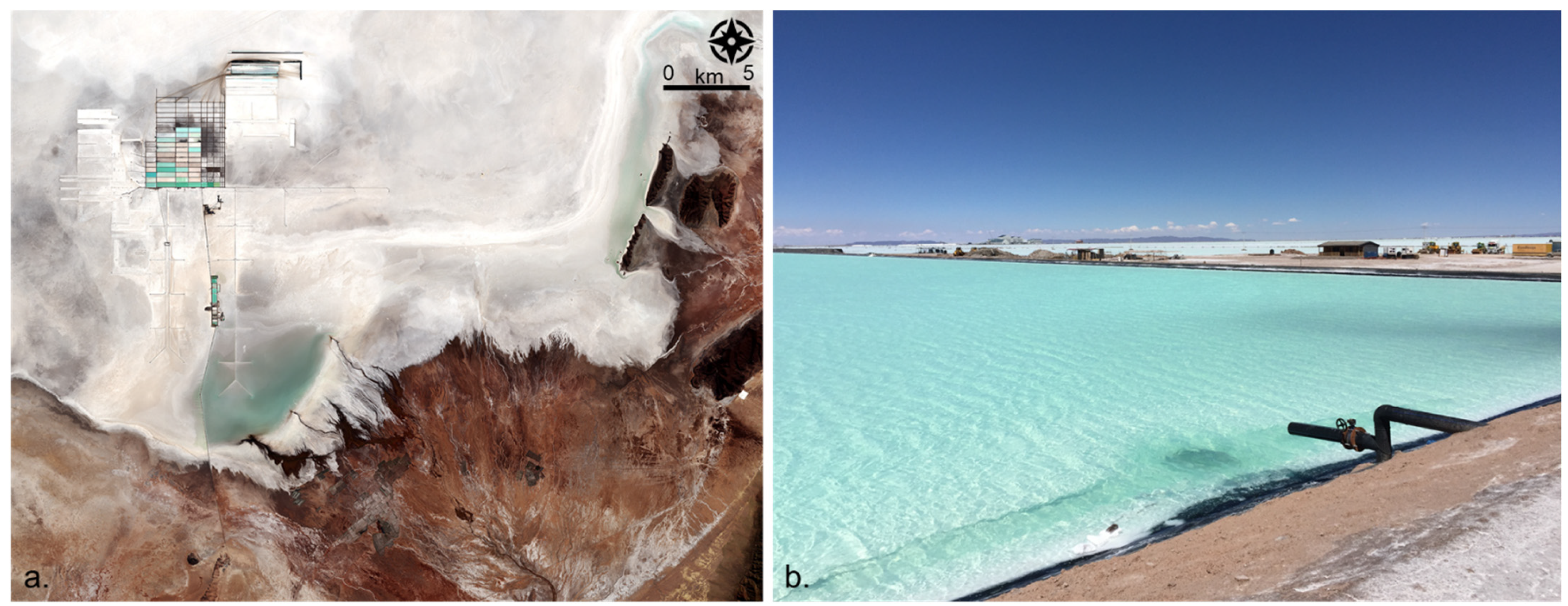
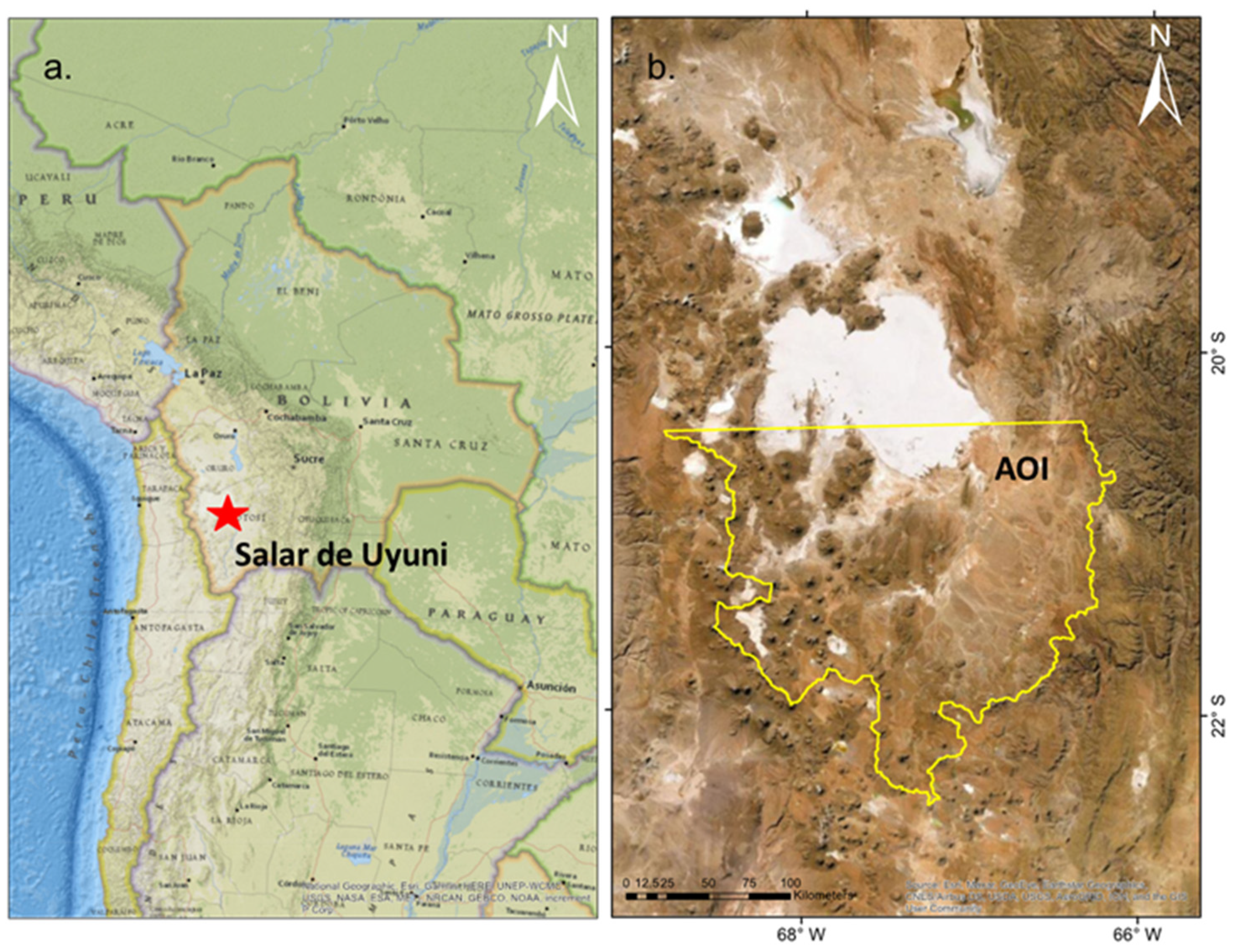
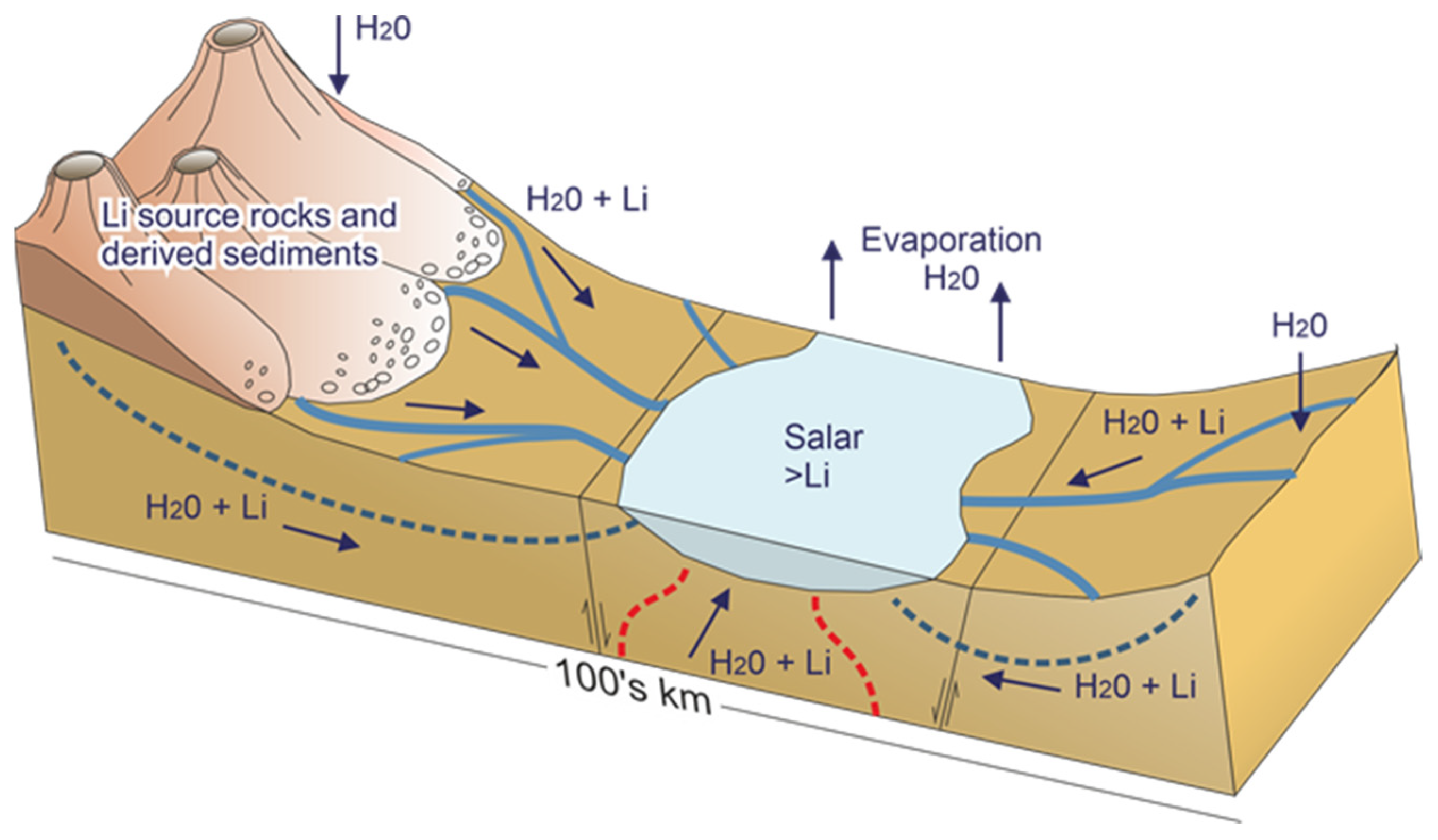
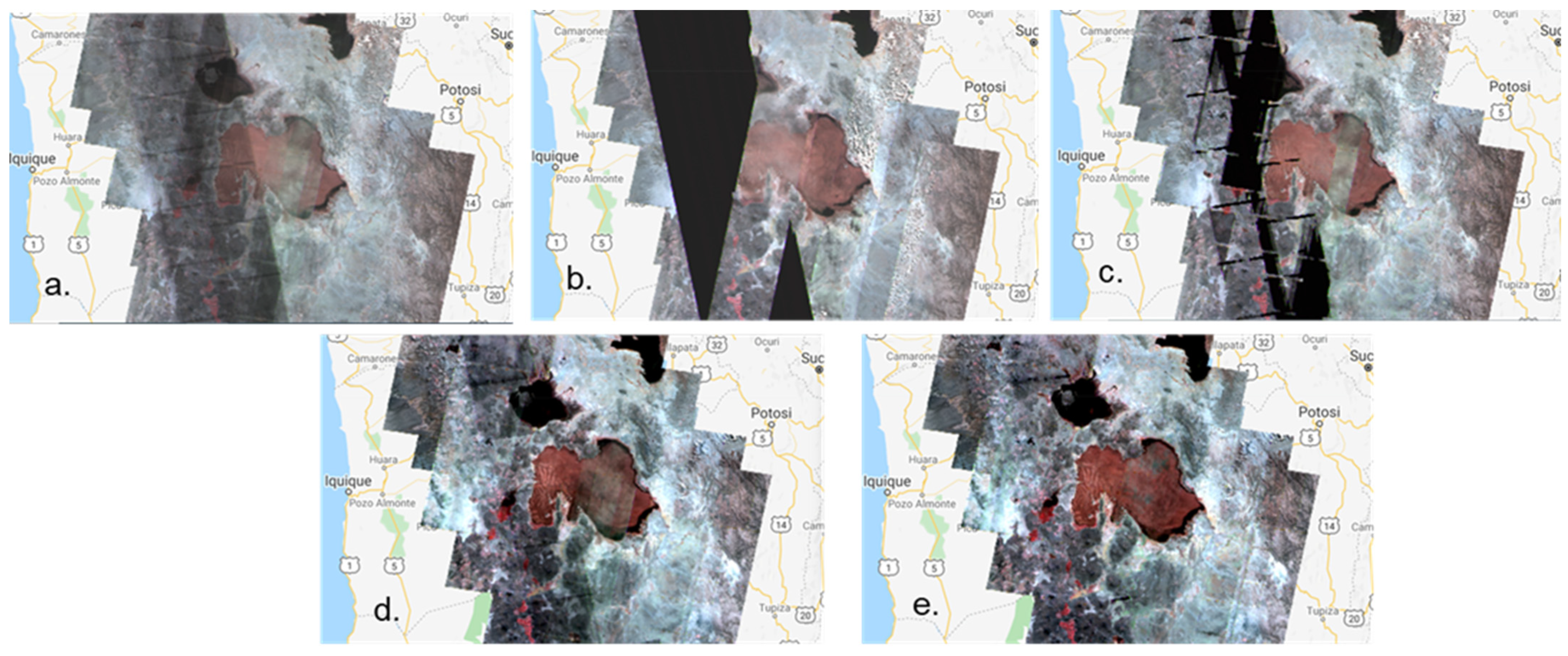

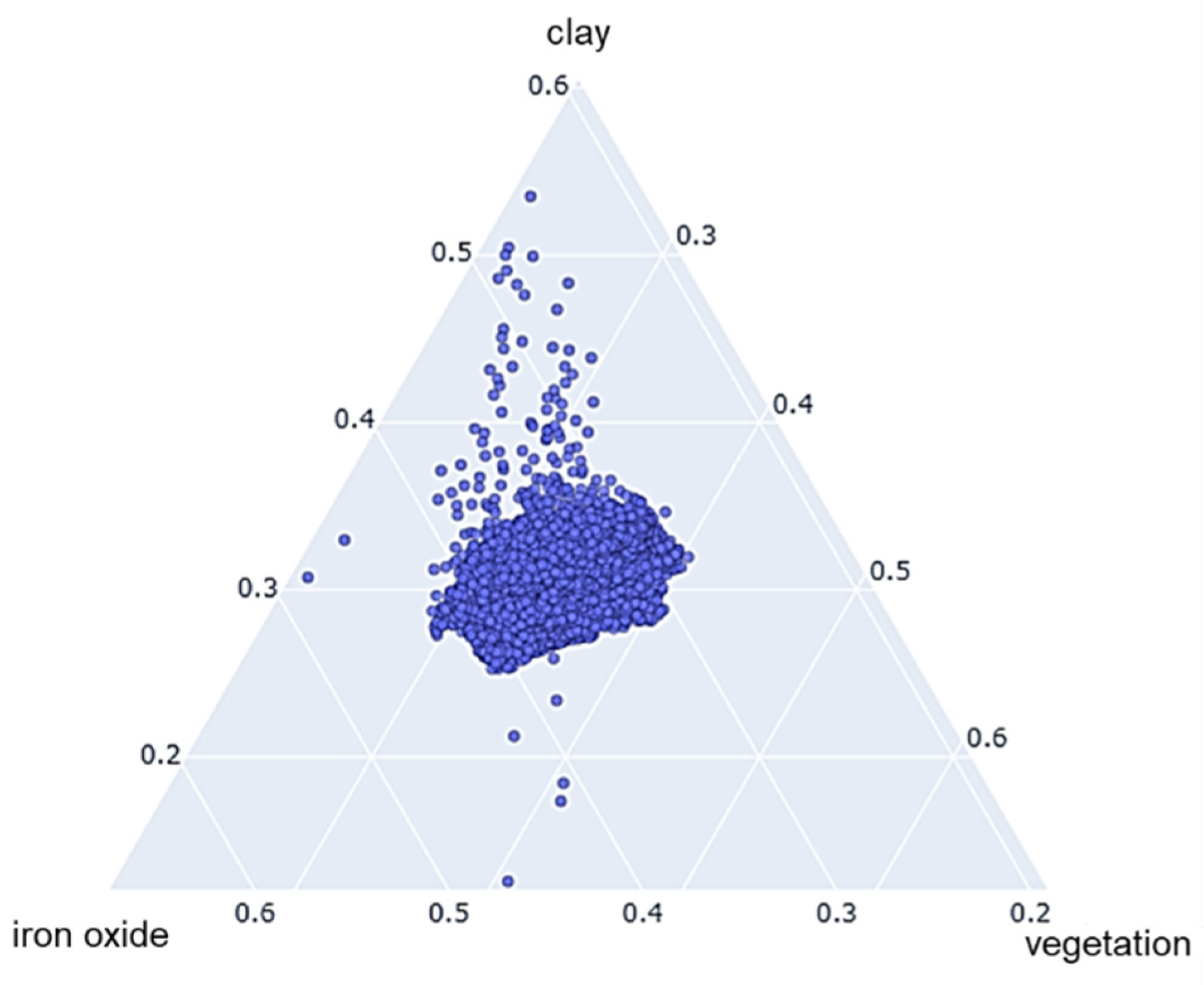
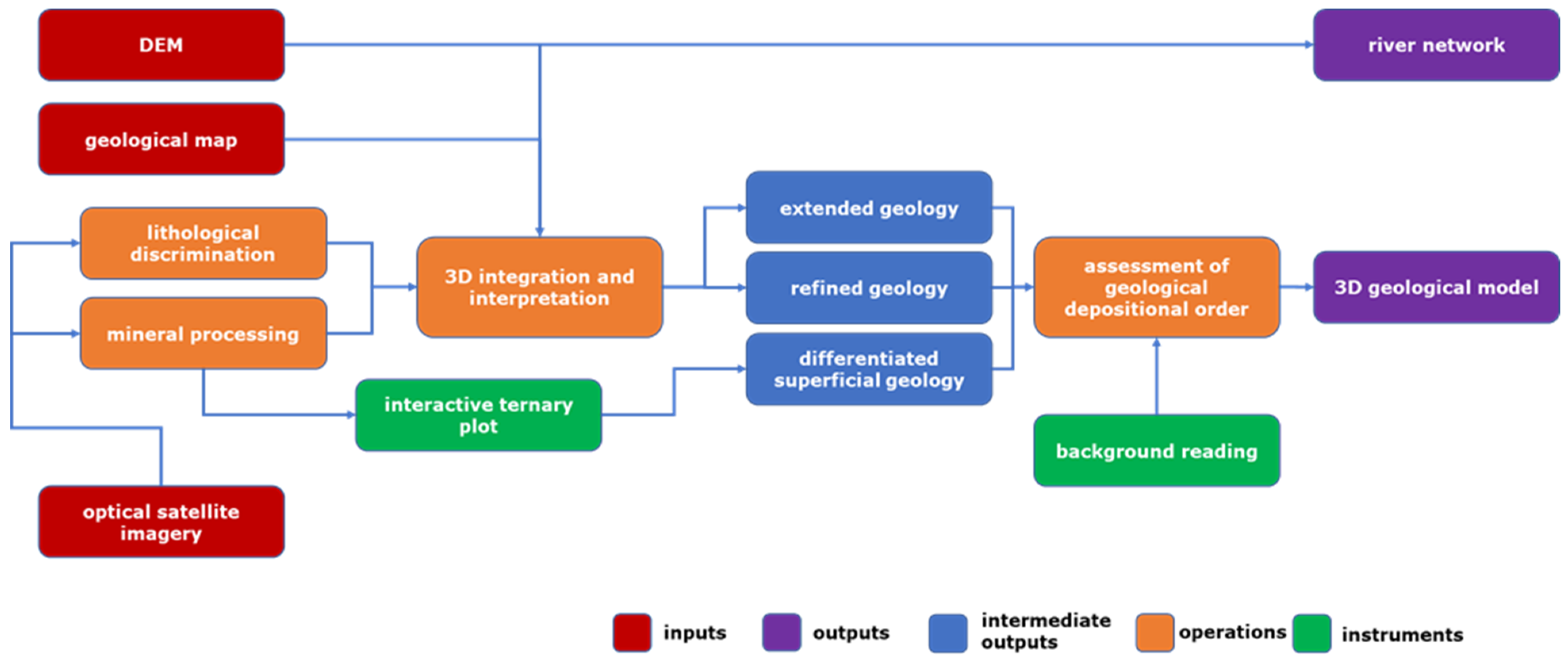
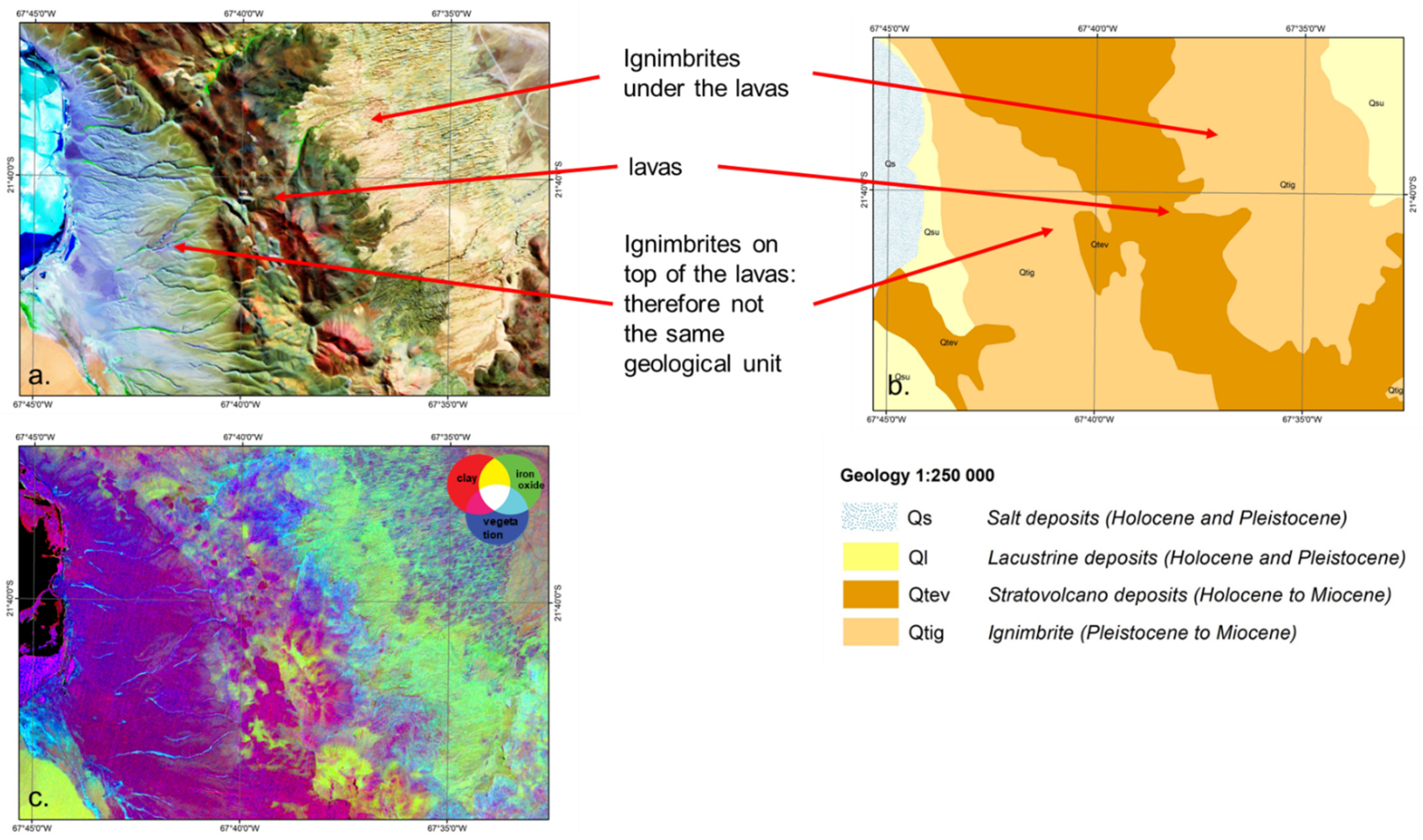
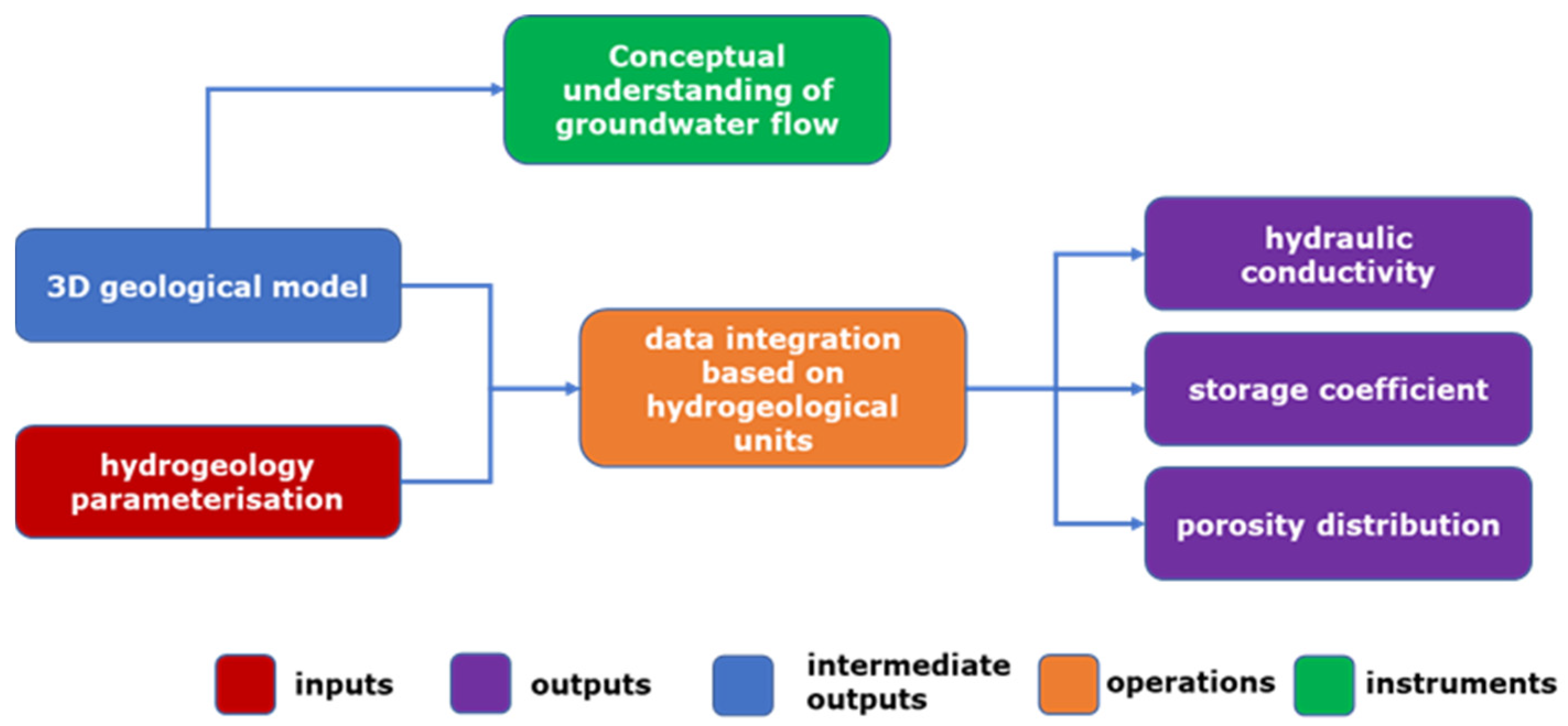
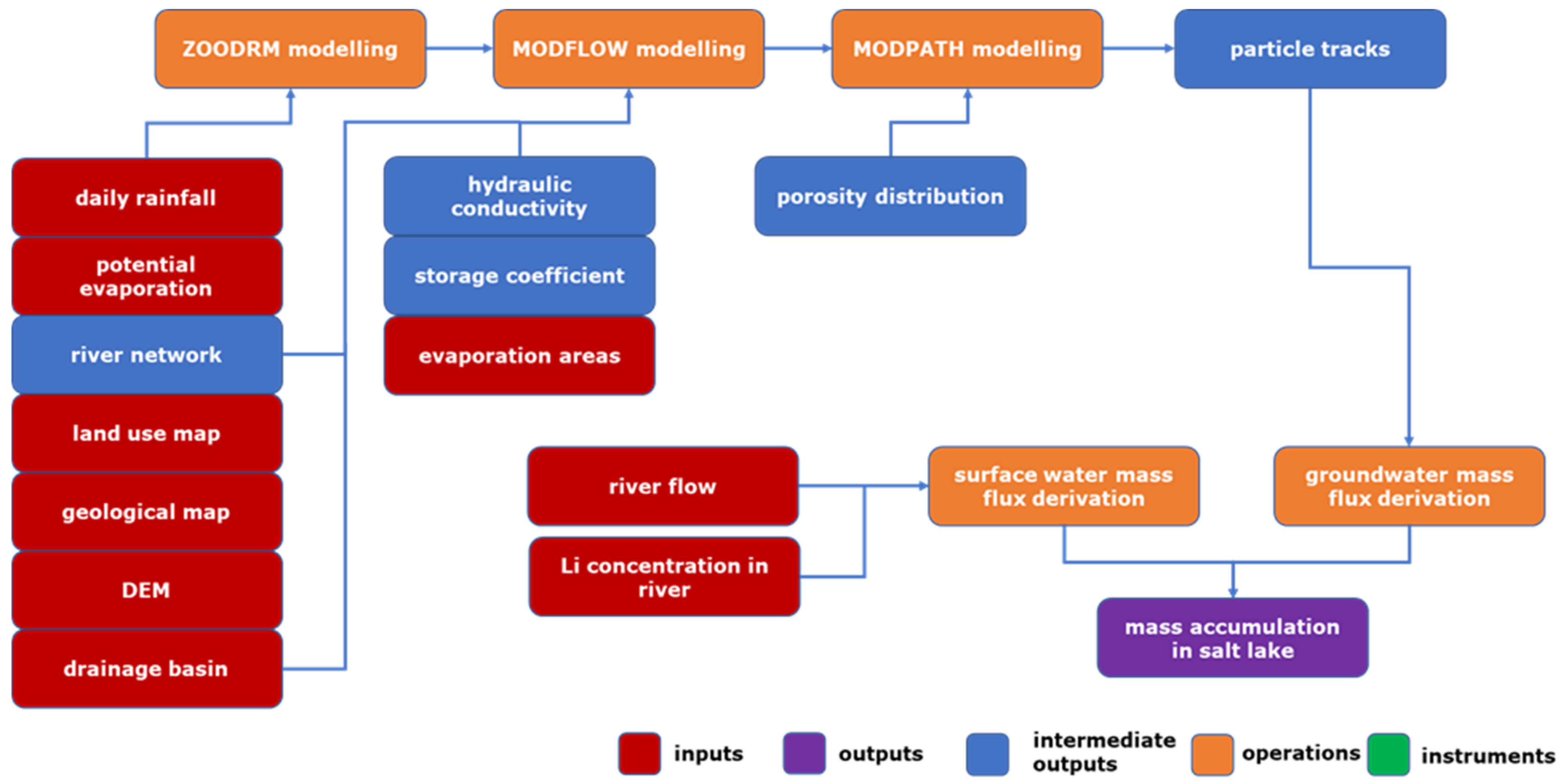

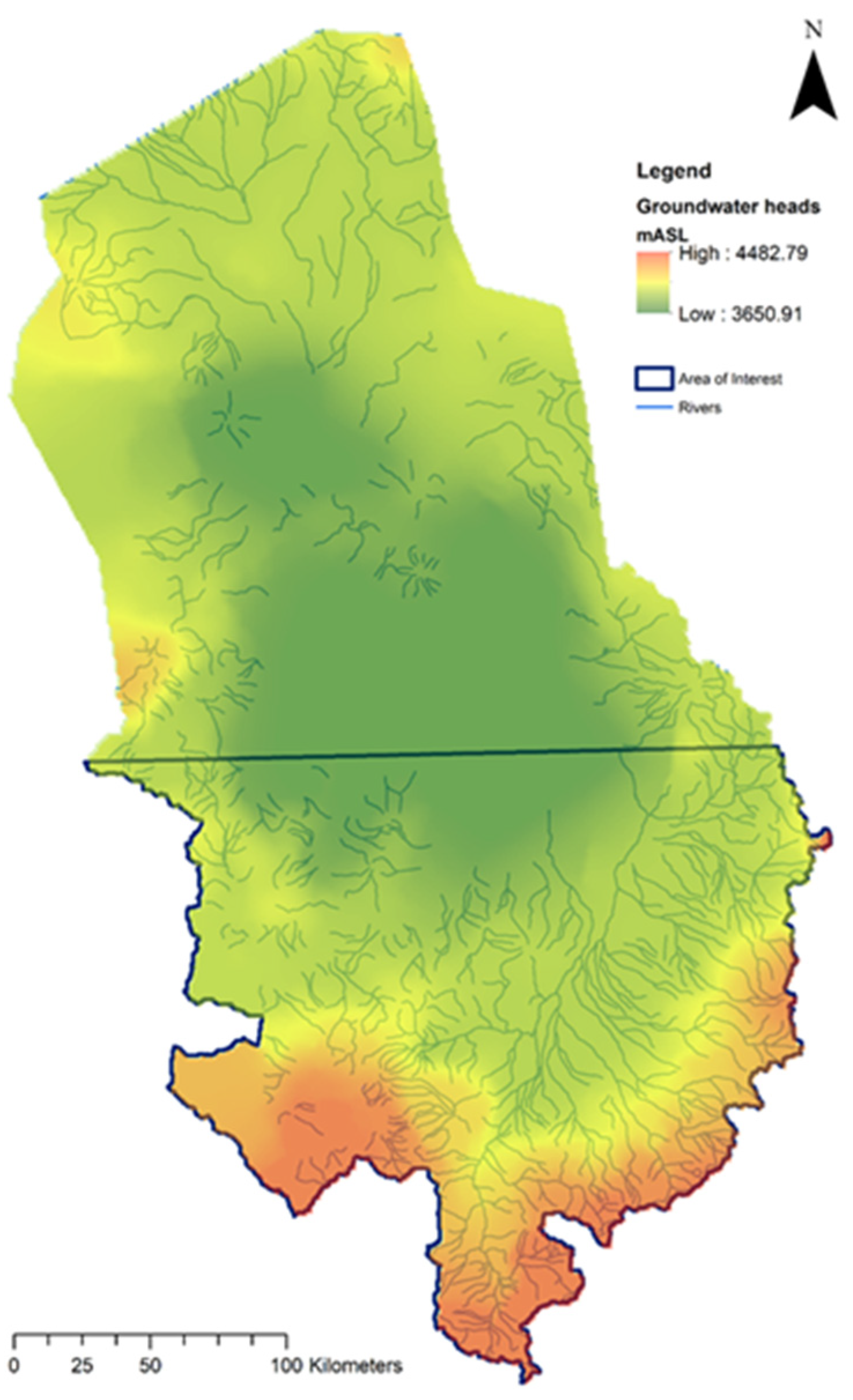
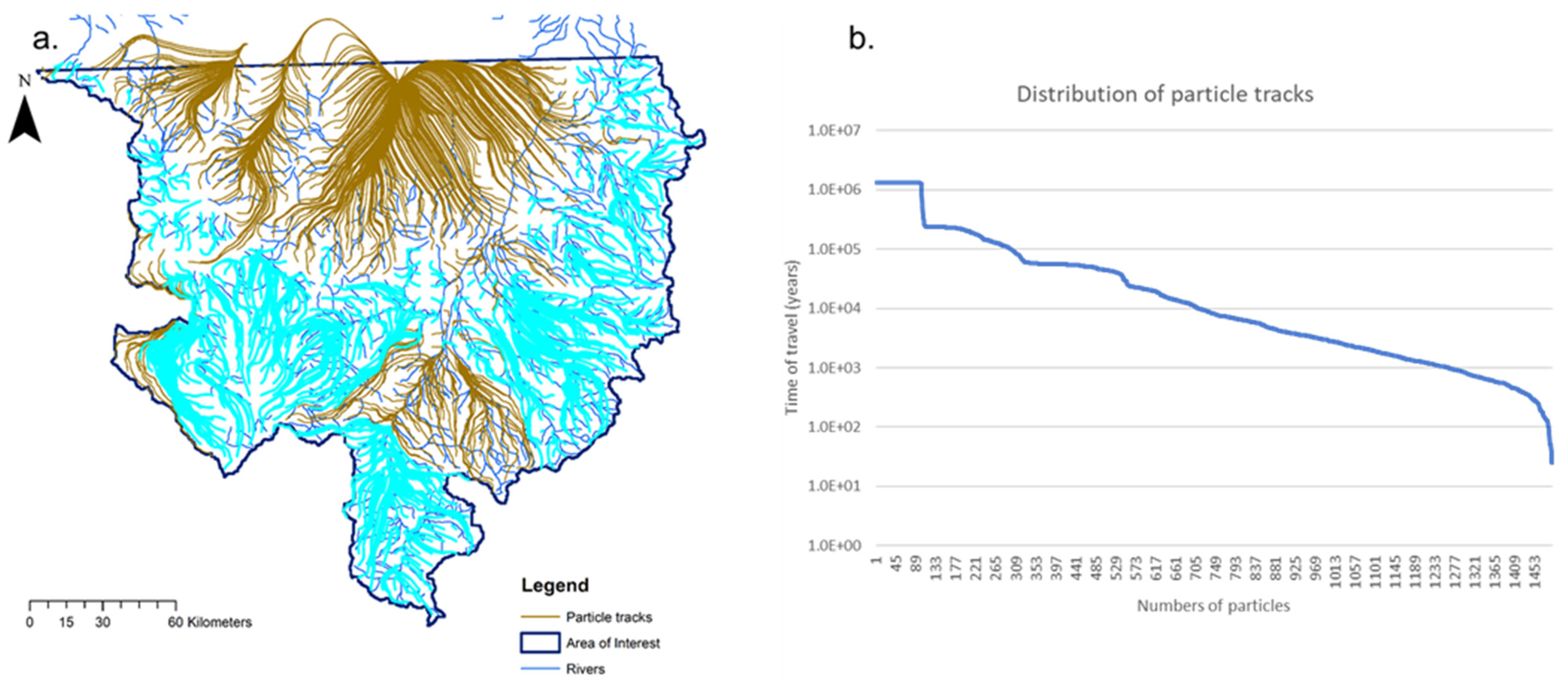

| Dataset | Workflow |
|---|---|
| ASTER | G |
| Landsat-8 | G |
| SRTM | G |
| USGS 1:500 k geological map | G, MB |
| GEOBOL 1:250 k geological maps | G |
| ERA5 | MB |
| CCI Land Cover | MB |
| WWF HydroSHEDS | MB |
| Parameters from available literature (hydrogeology, river flow, Li concentration) | H, MB |
Publisher’s Note: MDPI stays neutral with regard to jurisdictional claims in published maps and institutional affiliations. |
© 2022 by the authors. Licensee MDPI, Basel, Switzerland. This article is an open access article distributed under the terms and conditions of the Creative Commons Attribution (CC BY) license (https://creativecommons.org/licenses/by/4.0/).
Share and Cite
Rossi, C.; Bateson, L.; Bayaraa, M.; Butcher, A.; Ford, J.; Hughes, A. Framework for Remote Sensing and Modelling of Lithium-Brine Deposit Formation. Remote Sens. 2022, 14, 1383. https://doi.org/10.3390/rs14061383
Rossi C, Bateson L, Bayaraa M, Butcher A, Ford J, Hughes A. Framework for Remote Sensing and Modelling of Lithium-Brine Deposit Formation. Remote Sensing. 2022; 14(6):1383. https://doi.org/10.3390/rs14061383
Chicago/Turabian StyleRossi, Cristian, Luke Bateson, Maral Bayaraa, Andrew Butcher, Jonathan Ford, and Andrew Hughes. 2022. "Framework for Remote Sensing and Modelling of Lithium-Brine Deposit Formation" Remote Sensing 14, no. 6: 1383. https://doi.org/10.3390/rs14061383
APA StyleRossi, C., Bateson, L., Bayaraa, M., Butcher, A., Ford, J., & Hughes, A. (2022). Framework for Remote Sensing and Modelling of Lithium-Brine Deposit Formation. Remote Sensing, 14(6), 1383. https://doi.org/10.3390/rs14061383






